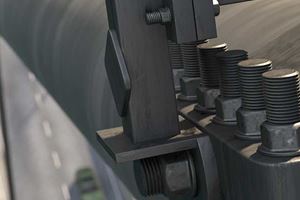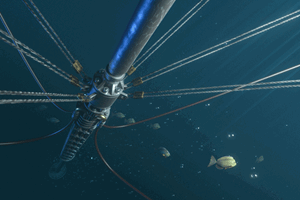Extreme temperatures
Impact of extreme temperatures on metallic materials
A meteorite that crashed into Earth around 35 million years ago produced what is believed to be the hottest-ever naturally-occurring temperature on our planet. Scientists estimate that a temperature of 2370°C, which is about half as hot as the Sun’s surface, was reached via this extraterrestrial impact.
On the opposite end of the scale, the lowest natural temperature ever directly recorded at ground level on Earth is −89.2°C at the Soviet Vostok Station in Antarctica on 21 July 1983.
Heading down toward ‘Absolute Zero’
While the temperatures mentioned were naturally occurring, the temperatures that metals in industrial applications are subjected to sometimes approach those ranges, leading to significant challenges. Just think about a jet engine: Temperatures can reach 900°C, while industrial ovens can go to 1200°C. On the opposite cold end of the scale, cryogenics may involve exposure to temperatures of −196°C or even as low as −269°C. For anyone who recalls their high school physics, this is just slightly above “absolute zero” which at −273°C is the lowest possible temperature — where nothing could be colder, and no heat energy remains in a substance.
Therefore, when designing equipment for any application involving either very low or high temperatures or wide swings in temperatures, it’s especially important to consider the effects these temperatures will have on the metals being used. There are dozens of bolting and fastening applications that may involve extreme temperatures.
The science of metallurgy studies the ways in which various metals behave over wide temperature ranges, and also how specific metals or combinations of metals can help mitigate possible negative effects.
Thus, steel and other metal alloys can be tailored to meet the requirements of an application that is subjected to temperature extremes.
The challenges that low temperatures pose
The primary adverse effects that low temperatures cause are the loss of ductility (the ability to undergo plastic deformation before rupture) and increasing embrittlement of the material as the temperature falls below what is called the ductile-to-brittle transition temperature or DBTT.
“A ductile material will first deform before finally fracturing,” explains Alexandre Fleurentin, an expert in the area of metallurgy and heat and surface treatments, and founder of the company Métallo Corner in France, “while a brittle material will more likely break immediately when a load exceeds its yield strength.”
As temperature decreases many materials shift from ductile to brittle behavior at the DBTT. Obviously, shattering is more likely to have negative consequences, compared with deforming, and at very low temperature steels generally tend to be more sensitive to impacts, with a risk of breaking in case of a sudden shock or bending. This characteristic is close to resilience and is evaluated under the impact test.
On the other hand, lower temperature frequently results in an increase of mechanical tensile strength of metal and less elongation at break. To keep the mechanical strength high and achieve a less brittle material, austenitic stainless steels with a high content of nickel and nitrogen are often preferred.
High temperature is even more complex
At extremely high temperatures, there are some reversible phenomena that occur, while others are permanent. Reversible ones, which regress if the temperature returns to what is considered normal, include a temporary loss of mechanical tensile strength and changes in ductility.
Regarding the permanent phenomena, aging and heat-treatment processes occurring at elevated temperatures can cause over-tempering, which results in reduced fatigue resistance. Therefore, the temperature of the service should also remain under the annealing or tempering temperature of the steel.
In stainless steel, high temperatures can lead to the loss or decrease of the protective passivating layer, so at these temperatures, the designer must be careful about ambient factors such as humidity and certain elements in the atmosphere. “Even fluids, which have an indirect impact on metal performance, can be influenced,” says Fleurentin. “For example, at high temperatures some lubricants like molybdenum disulfide (MoS2) change properties and completely lose their lubrication ability (MoS2 becomes MoS3 = molybdenum trisulfide), leading to possible problems.”
Creep and relaxation are also heat activated
The important, and often detrimental, phenomena of creep and relaxation can also be activated at high temperatures. Creep is when a material deforms slowly and permanently due to constant mechanical stress, even though it is below the material’s yield strength. Relaxation is when the material, even though it is initially loaded below its yield strength, releases stress when exposed to a fixed strain by transforming a portion of this elastic deformation into plastic deformation.
Creep or relaxation in metals both occur more readily if subjected to elevated temperatures, even before the loads or deformations exceed the yield strength of the material. The extent of creep or relaxation depends on the amount of stress, the temperature and time of exposure. These phenomena can be activated from about 200°C for steels and as low as just over 100°C for some light alloys and stainless steel. To meet really challenging applications, designers may choose to use creep-resistant alloys that are nickel-based or cobalt-based. Keep in mind that creep and relaxation permanently modify the parts in terms of deformation or stress relief.
Coefficient of thermal expansion varies over wide temperature ranges
Another result of extreme temperatures is that material will expand or contract in proportion to the temperature, due to physics. So when the temperature rises in a steel structure the atoms start to vibrate more and more. This thermal agitation, in turn, leads to an increase in interatomic distances and thus causes an expansion in the material.
The actual expansion that occurs with increasing temperature is described by what is called the coefficient of linear thermal expansion (CTE), which is normally defined at 20°C for various materials. It is generally constant over a particular temperature range, say from 0 to 100°C. However, states Mr. Fleurentin, “the CTE for a given material is not always constant over a wide range of extreme temperatures so it is usually updated every 100°C.”
“In addition to the fact that the CTE itself can vary with temperature, the designer must also take into account aging and changes in material properties over the service time. These are both tremendously important for any type of equipment or bolting and fastening solution, that will be facing extreme temperatures.”





